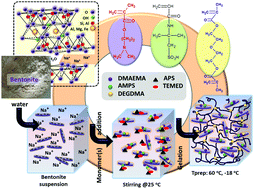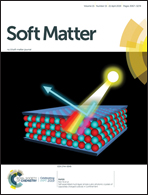A versatile strategy for mechanically durable nanocomposite cryogels based on cationic (alkyl)methacrylates and hydrophilic bentonite via freezing (cryo)polymerization
Abstract
A simple strategy for the preparation of organic–inorganic (alkyl)methacrylate-based nanocomposite gels was established. The preparation procedure was based on free-radical copolymerization of cationic monomer N,N-dimethylaminoethyl methacrylate (DMAEMA) in the presence of a low amount of ionic comonomer 2-acrylamido-2-methyl-propanosulfonic acid (AMPS), nanoclay bentonite (BENT) and diethyleneglycol dimethacrylate (DEGDMA) as a chemical crosslinker. The parameters of equilibrium volume swelling, initial swelling rate, diffusional exponent, and early- and late-time diffusion coefficients were evaluated from the swelling measurements in salt solutions. PDMAEMA retained its own characteristics regardless of the amounts of ionic comonomer AMPS and nanoclay bentonite. The prepared nanocomposite cryogels/hydrogels were found to be pH and temperature-responsive. The elastic moduli and compressibility of the nanocomposite NC/BENTm-Cgels were much higher than those of NC/BENTm-Hgels. The effective crosslink density distribution of the nanocomposite NC/BENTm-Hgels was evaluated from the elastic moduli data of the as-prepared state and the degree of crosslinking was described by a quadratic polynomial as a function of the clay concentration. At high clay content, the nanocomposite NC/BENTm gels exhibited a lower swelling degree, and thus a higher crosslinking density than the clay-free gels. Both NC/BENTm Hgels and Cgels exhibited obvious pH and temperature double sensitiveness; the equilibrium degree of swelling decreased as the solution's pH or the swelling temperature increased. The power law exponent values obtained from dynamic swelling in aqueous Na2SO4 solution indicated that the sorption mechanism of both the nanocomposite NC/BENTm-Hgel and NC/BENTm-Cgel samples was Fickian controlled. Overall, this study successfully establishes the thermodynamic relations between the physico-mechanical behavior and characteristic network parameters of (alkyl)methacrylate-based nanocomposite gels prepared at various BENT concentrations.



 Please wait while we load your content...
Please wait while we load your content...